Exploring Objects, Materials and Fasteners
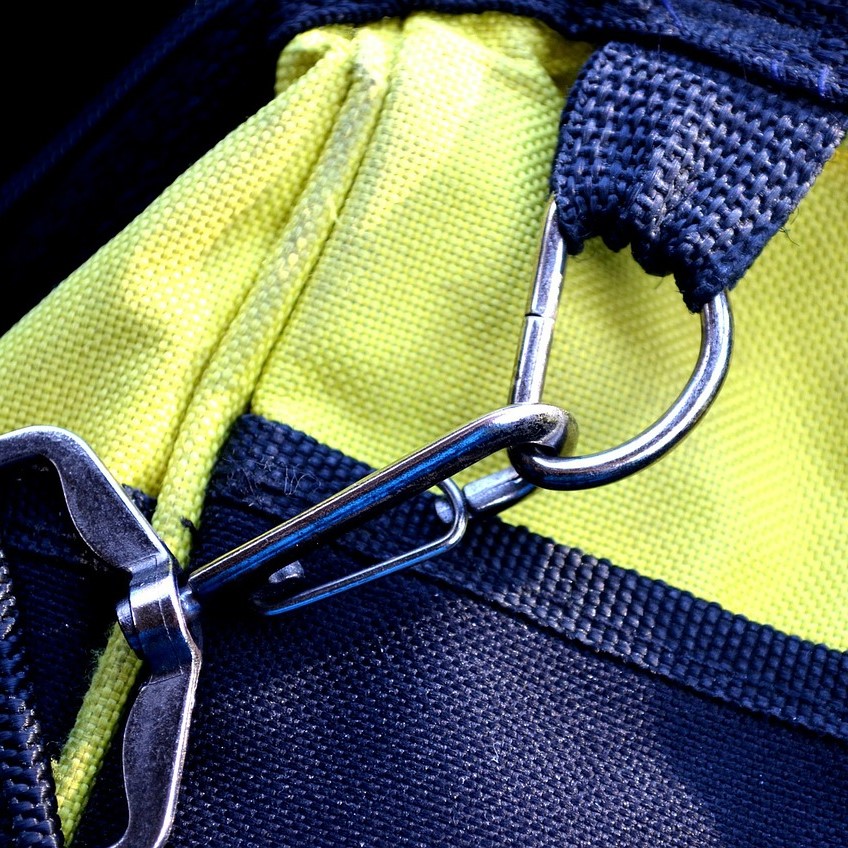
Swivel hook fastener (PublicDomainPictures, Pixabay)

Swivel hook fastener (PublicDomainPictures, Pixabay)
How does this align with my curriculum?
| Grade | Course | Topic |
|---|
Students identify and sort objects, including fasteners, according to material and purpose.
Overview
| Activities | Timing | Student grouping | Description |
|---|---|---|---|
| Minds-On: Introduction to Materials, Fasteners and Objects | 10-15 minutes | Large group | Students learn about materials, fasteners and objects used in everyday life. |
| Action: Exploring Materials, Fasteners and Objects | 40-50 minutes | Small group | Students explore the differences between materials, fasteners and objects by participating in centre activities. |
| Consolidation: Show What You Know | 20-30 minutes | Large group | Students consolidate their learning through a large group sorting activity. |
This lesson can be done over a few days.
Students will:
- Examine different types of materials, fasteners and objects
- Explore the different uses for materials, fasteners and objects
Learning Goals
Students will:
- Examine different types of materials, fasteners and objects
- Explore the different uses for materials, fasteners and objects
Students can:
- Identify materials that are used to make various everyday objects, including structures
- Identify different kinds of fasteners and describe uses for each
- Sort objects by material
- Sort fasteners by type and how they are used
Success Criteria
Students can:
- Identify materials that are used to make various everyday objects, including structures
- Identify different kinds of fasteners and describe uses for each
- Sort objects by material
- Sort fasteners by type and how they are used
This icon indicates potential assessment opportunities.
Observations
- Observe and record anecdotally students’ participation and sharing during the group discussions (Action) and (Consolidation).
Conversations
- Listen to and record students as they share how they sorted objects according to material and fastener at Centre Activity 1 (Action).
- Have conversations with students about the different materials, fasteners and objects found in the interactive online activity (Action).
Products
- Students demonstrate understanding of the materials and fasteners by completing the Make a Match activity (Action).
Evidence of Student Learning
This icon indicates potential assessment opportunities.
Observations
- Observe and record anecdotally students’ participation and sharing during the group discussions (Action) and (Consolidation).
Conversations
- Listen to and record students as they share how they sorted objects according to material and fastener at Centre Activity 1 (Action).
- Have conversations with students about the different materials, fasteners and objects found in the interactive online activity (Action).
Products
- Students demonstrate understanding of the materials and fasteners by completing the Make a Match activity (Action).
Students will:
- Examine different types of materials, fasteners and objects
- Explore the different uses for materials, fasteners and objects
Learning Goals
Students will:
- Examine different types of materials, fasteners and objects
- Explore the different uses for materials, fasteners and objects
Students can:
- Identify materials that are used to make various everyday objects, including structures
- Identify different kinds of fasteners and describe uses for each
- Sort objects by material
- Sort fasteners by type and how they are used
Success Criteria
Students can:
- Identify materials that are used to make various everyday objects, including structures
- Identify different kinds of fasteners and describe uses for each
- Sort objects by material
- Sort fasteners by type and how they are used
This icon indicates potential assessment opportunities.
Observations
- Observe and record anecdotally students’ participation and sharing during the group discussions (Action) and (Consolidation).
Conversations
- Listen to and record students as they share how they sorted objects according to material and fastener at Centre Activity 1 (Action).
- Have conversations with students about the different materials, fasteners and objects found in the interactive online activity (Action).
Products
- Students demonstrate understanding of the materials and fasteners by completing the Make a Match activity (Action).
Evidence of Student Learning
This icon indicates potential assessment opportunities.
Observations
- Observe and record anecdotally students’ participation and sharing during the group discussions (Action) and (Consolidation).
Conversations
- Listen to and record students as they share how they sorted objects according to material and fastener at Centre Activity 1 (Action).
- Have conversations with students about the different materials, fasteners and objects found in the interactive online activity (Action).
Products
- Students demonstrate understanding of the materials and fasteners by completing the Make a Match activity (Action).
Materials and Preparation
| Material/Technology/Setting | Quantity |
|---|---|
|
For all centres
|
For student use |
|
Centre Activity 1: Sorting Activity
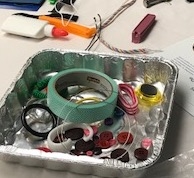
Image - Text VersionShown is a colour photograph of tape, buttons, wire, string, glue and other objects.
|
Enough to fill and organize into four different boxes or baskets |
|
Centre Activity 2: Matching Activity
Note: If students are having difficulty holding/using a marker, use laminated versions of the reproducible along with string and tape, play doh or clay. Students use the physical materials to indicate connections between the pictures. |
1 per student or pair of students at the centre |
|
Centre Activity 3: Interactive Exploration
|
Enough for 1 per student or small group |
|
For teacher use |
Materials
| Material/Technology/Setting | Quantity |
|---|---|
|
For all centres
|
For student use |
|
Centre Activity 1: Sorting Activity

Image - Text VersionShown is a colour photograph of tape, buttons, wire, string, glue and other objects.
|
Enough to fill and organize into four different boxes or baskets |
|
Centre Activity 2: Matching Activity
Note: If students are having difficulty holding/using a marker, use laminated versions of the reproducible along with string and tape, play doh or clay. Students use the physical materials to indicate connections between the pictures. |
1 per student or pair of students at the centre |
|
Centre Activity 3: Interactive Exploration
|
Enough for 1 per student or small group |
|
For teacher use |
- Gather the materials, fasteners and objects that you will provide for Centre Activity 1 and organize Sorting Mats.
- Print out and laminate (if you wish) the Make a Match reproducible if you wish to have students use washable or dry erase markers.
- Print out and laminate (if you wish) the images for the Show What You Know About Materials, Objects and Materials pocket chart activity.
- Ensure students have access to computers for Centre Activity 3.
- If using the Google Jamboard, make a copy for yourself before sharing with students.
Preparation
- Gather the materials, fasteners and objects that you will provide for Centre Activity 1 and organize Sorting Mats.
- Print out and laminate (if you wish) the Make a Match reproducible if you wish to have students use washable or dry erase markers.
- Print out and laminate (if you wish) the images for the Show What You Know About Materials, Objects and Materials pocket chart activity.
- Ensure students have access to computers for Centre Activity 3.
- If using the Google Jamboard, make a copy for yourself before sharing with students.
- It is highly recommended that students conduct the lesson Which Fastener is Best in addition to participating in this lesson.
- Working independently at a centre
- Familiarity with the concept of sorting
Student Prior Knowledge and Skills
- It is highly recommended that students conduct the lesson Which Fastener is Best in addition to participating in this lesson.
- Working independently at a centre
- Familiarity with the concept of sorting
| Material/Technology/Setting | Quantity |
|---|---|
|
For all centres
|
For student use |
|
Centre Activity 1: Sorting Activity

Image - Text VersionShown is a colour photograph of tape, buttons, wire, string, glue and other objects.
|
Enough to fill and organize into four different boxes or baskets |
|
Centre Activity 2: Matching Activity
Note: If students are having difficulty holding/using a marker, use laminated versions of the reproducible along with string and tape, play doh or clay. Students use the physical materials to indicate connections between the pictures. |
1 per student or pair of students at the centre |
|
Centre Activity 3: Interactive Exploration
|
Enough for 1 per student or small group |
|
For teacher use |
Materials
| Material/Technology/Setting | Quantity |
|---|---|
|
For all centres
|
For student use |
|
Centre Activity 1: Sorting Activity

Image - Text VersionShown is a colour photograph of tape, buttons, wire, string, glue and other objects.
|
Enough to fill and organize into four different boxes or baskets |
|
Centre Activity 2: Matching Activity
Note: If students are having difficulty holding/using a marker, use laminated versions of the reproducible along with string and tape, play doh or clay. Students use the physical materials to indicate connections between the pictures. |
1 per student or pair of students at the centre |
|
Centre Activity 3: Interactive Exploration
|
Enough for 1 per student or small group |
|
For teacher use |
- Gather the materials, fasteners and objects that you will provide for Centre Activity 1 and organize Sorting Mats.
- Print out and laminate (if you wish) the Make a Match reproducible if you wish to have students use washable or dry erase markers.
- Print out and laminate (if you wish) the images for the Show What You Know About Materials, Objects and Materials pocket chart activity.
- Ensure students have access to computers for Centre Activity 3.
- If using the Google Jamboard, make a copy for yourself before sharing with students.
Preparation
- Gather the materials, fasteners and objects that you will provide for Centre Activity 1 and organize Sorting Mats.
- Print out and laminate (if you wish) the Make a Match reproducible if you wish to have students use washable or dry erase markers.
- Print out and laminate (if you wish) the images for the Show What You Know About Materials, Objects and Materials pocket chart activity.
- Ensure students have access to computers for Centre Activity 3.
- If using the Google Jamboard, make a copy for yourself before sharing with students.
- It is highly recommended that students conduct the lesson Which Fastener is Best in addition to participating in this lesson.
- Working independently at a centre
- Familiarity with the concept of sorting
Student Prior Knowledge and Skills
- It is highly recommended that students conduct the lesson Which Fastener is Best in addition to participating in this lesson.
- Working independently at a centre
- Familiarity with the concept of sorting
Teaching and Learning Activities
This icon indicates potential assessment opportunities.
Minds-On: Introduction to Materials, Fasteners and Objects (10-15 min.)
| Instructions | Teaching Tips |
|---|---|
|
Show students the slideshow Objects, Materials and Fasteners slideshow [Google slides] [pptx] [PDF]. On each slide, pause after asking the question at the top of the slide. After students share responses, click to have suggested answers appear on screen. 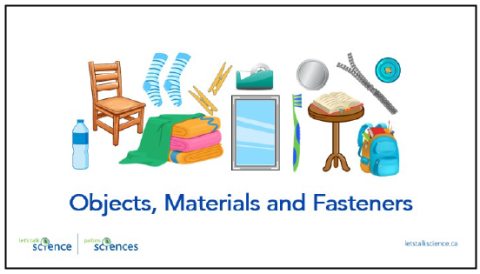
In addition, students could be provided with physical objects to interact with that are similar to those used in the slide show. Students could hold up the objects when they are mentioned in the slideshow. |
LanguageConsider creating a word wall of terminology, along with pictures, that students will encounter over the course of this lesson such as material, wood, metal, glass, plastic, fabric fastener, thumb tack, clothes pin, tape, screws, object. You could use the What You Know About Materials, Objects and Materials reproducible [Google doc] [Word doc] [PDF] For French immersion students, both English and French words could be used. DiscussionsStudents may naturally want to offer their own examples in these discussions. Allow them time and be prepared that they will want to demonstrate their knowledge right away. Community ConnectionsEncourage students who may have different ways of knowing and feel comfortable sharing them to explain some of the traditional items that are used within their communities as materials and fasteners used to make objects. Tipis and wigwams are examples of traditional First Nations structures that are created with materials and fasteners found in the natural environment. It is important to remember that these diverse First Nations, Inuit and Metis groups are still around. Some are our friends, neighbours, our classmates or members of our families. As we learn about their ways of knowing it is important to do so with respect and gratitude. Images and VideosDescribe the images in the slideshow for students with visual impairments. In addition, for students with hearing impairments, provide them with physical objects to interact with and ask them what sounds they associate with the items and include them in the descriptors of the items. |
Action: Exploring Materials, Fasteners and Objects 15 min. each (45 min. total)
| Instructions | Teaching Tips |
|---|---|
|
Divide students into groups to do centre activities. Activities could be done concurrently or sequentially. Give students a brief description of what they will be doing at each centre. |
LanguageReview the concept of “sorting” to ensure students understand the concept before beginning the activities. Suggested prompts can include:
|
|
Centre Activity 1: Sorting Objects by Materials and Fasteners This centre activity is best done in groups of four, but other sizes of student groups could also be used. Randomly organize the objects made of different materials and including different fasteners into four small bins or baskets. Set these, along with the four sets of sorting tools out at a centre. Have students individually or in pairs sort the items in their basket:
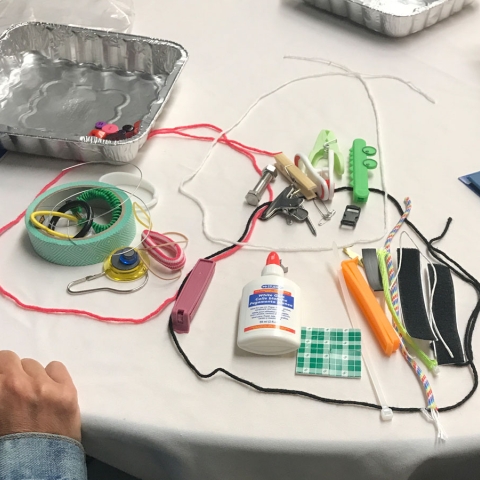
Image - Text VersionShown is a colour photograph of the objects from the first image, sorted into three groups. Observe and have conversations with students about how they are sorting the objects after each instance of sorting. After each group has completed their sorting, they pass their bin to another group and repeat the process using new objects. Students continue sorting and passing objects until they have sorted each of the bins. Encourage students to put all of the objects back into their respective bins before leaving the centre. |
IdeaReview and incorporate the learning strategy of Sorting Mats to support students’ development of the skill of sorting and classifying. Community ConnectionsUse objects that are relevant and familiar to students as well as ones which are new to them. LanguageAdd the names of objects and words for materials used in the sorting to a word wall along with images of the objects. The words could be arranged in such a way to support students in sorting. DiscussionsDiscussion prompts can include:
|
|
Centre 2: Make a Match This centre activity is best done individually or in pairs. Provide students at this centre with laminated Make a Match reproducible [Google doc] [Word doc] [PDF] and dry erase or washable markers. 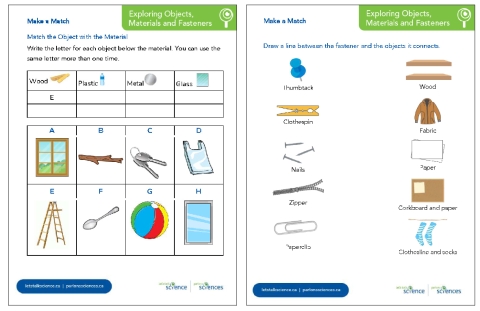
If using physical materials instead of markers, put these out at the centre. Observe and make notes or photograph each student’s completed Make a Match sheet before they wipe it off for the next student. If you wish to collect the activity sheets as documentation of student learning, then print enough copies of the reproducible for each student and have them complete on paper. |
DiscussionsDiscussion prompts can include:
IdeaThis is a good opportunity to review what a fastener is and how it works in relation to an object (e.g., a zipper on a coat holds two pieces of fabric together so that you can put it on and take it off easily and so that wind, snow and rain can’t get through.) |
|
Centre 3: Interactive Online Activity Students explore different materials, fasteners and objects by clicking on different objects in this interactive presentation. Note: Alternatively, you could do this activity with students as a class once they have completed the first two centres. 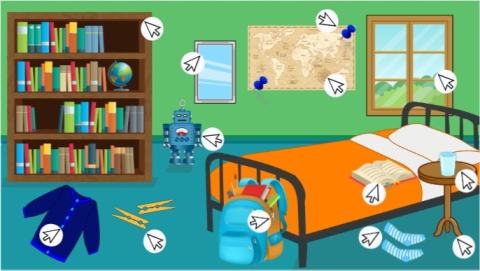
Students click on the arrows to go to a page about the given object or fastener. On that page, they will answer questions about the material of the object. Note: There are two questions per page. One has a correct answer, and one has an incorrect answer. There is a prompt for students to think about their answer before clicking on the box. 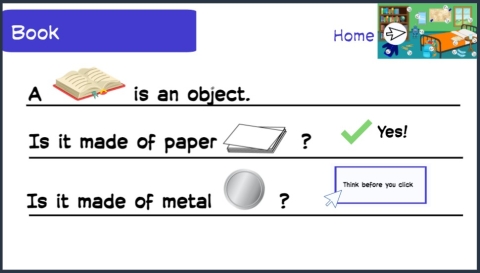
It is recommended that you do one of the examples together with the students by projecting the presentation on a screen. Using the main screen image, ask each student or pair of students what each object is made of. |
Consolidation: Show What You Know (10-15 min.)
| Instructions | Teaching Tips |
|---|---|
|
As a class, have students choose images from the Show What You Know About Materials, Objects and Materials reproducible [Google doc] [Google jamboard] [Word doc] [PDF] and place them below the correct header using a pocket chart, chalkboard or whiteboard with magnets or stick tack. 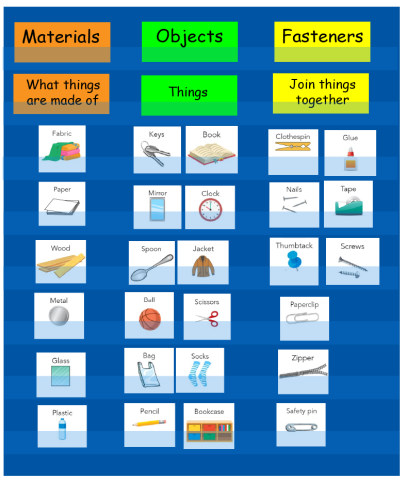
|
TechnologyAlternatively, use this Google jamboard to facilitate the consolidation activity. 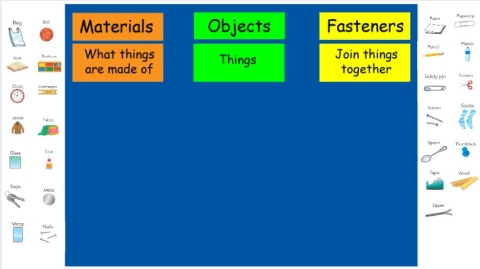
|
Background Information for Teachers
The Importance of Materials, Objects and Fasteners
Materials, fasteners and Objects hold an integral role in our everyday lives. Objects would not exist without materials. Objects would also fall apart without fasteners to hold them together. These things are all closely linked together to make up the majority of the things that surround us.
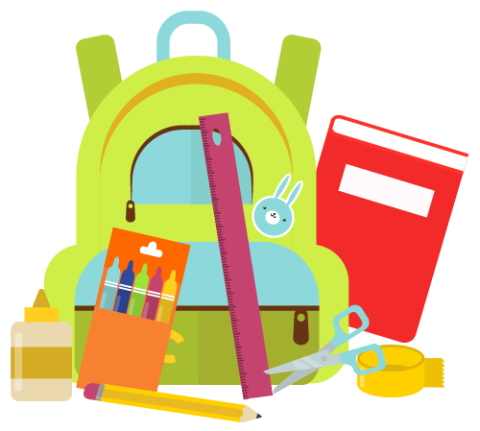
Image - Text Version
Shown is a colour illustration of a backpack and a collection of school supplies.
In the background are a green backpack and a black and red workbook. In the foreground is a ruler, a pencil, scissors, a package of markers, glue and tape.
Learning about materials, fasteners and objects allows students to develop a better understanding of the world around them. Many jobs require people to design, build and use all of these things. By becoming familiar with the world around them students become more confident.
Additional Resources
Reproducibles
- Make a Match reproducible [Google doc] [Word doc] [PDF]
- Online interactive activity: Materials, Fasteners and Objects
- Materials, Fasteners and Objects slideshow [Google slides] [pptx] [PDF]
- Show What You Know About Materials, Objects and Materials reproducible [Google doc] [Google jamboard] [Word doc] [PDF]
Books
Snap, Button, Zip: Inventions to Keep Your Clothes on
by Vicki Cobb
Presents a simple historical background on the things that fasten our clothes, such as elastic, zippers, buttons, and sticky tapes.
ISBN: 9780064461061
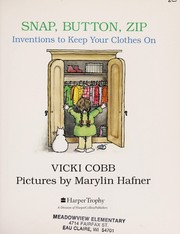
Videos
Materials And Their Properties (2020)
This YouTube video (3:38 min.) is about materials and their properties.
Materials Song (2012)
This YouTube video (2:26 min.) has a catchy song to help students remember the properties of common materials.
Reproducibles and Media
Reproducibles
- Make a Match reproducible [Google doc] [Word doc] [PDF]
- Online interactive activity: Materials, Fasteners and Objects
- Materials, Fasteners and Objects slideshow [Google slides] [pptx] [PDF]
- Show What You Know About Materials, Objects and Materials reproducible [Google doc] [Google jamboard] [Word doc] [PDF]
Books
Snap, Button, Zip: Inventions to Keep Your Clothes on
by Vicki Cobb
Presents a simple historical background on the things that fasten our clothes, such as elastic, zippers, buttons, and sticky tapes.
ISBN: 9780064461061

Videos
Materials And Their Properties (2020)
This YouTube video (3:38 min.) is about materials and their properties.
Materials Song (2012)
This YouTube video (2:26 min.) has a catchy song to help students remember the properties of common materials.
Science
- It is highly recommended that students conduct the lesson Which Fastener is Best in addition to participating in this lesson.
- Students could bring in additional objects from home to sort.
Mathematical Thinking
- Students could further organize objects or fasteners by new criteria.
- Students could create concrete object graphs of the sorting results at Centre 2.
Music
- Students could create a song or a rap about the differences between materials, fasteners and objects.
- Students could design a musical instrument that uses objects, materials and fasteners.
Extensions
Science
- It is highly recommended that students conduct the lesson Which Fastener is Best in addition to participating in this lesson.
- Students could bring in additional objects from home to sort.
Mathematical Thinking
- Students could further organize objects or fasteners by new criteria.
- Students could create concrete object graphs of the sorting results at Centre 2.
Music
- Students could create a song or a rap about the differences between materials, fasteners and objects.
- Students could design a musical instrument that uses objects, materials and fasteners.
"Uncovering Clever" Feature: Who Invented VELCRO Brand Fasteners?
This video (0:59) from Velcro® discusses the invention and development of Velcro® brand fasteners.
Learn More
"Uncovering Clever" Feature: Who Invented VELCRO Brand Fasteners?
This video (0:59) from Velcro® discusses the invention and development of Velcro® brand fasteners.
Reproducibles
- Make a Match reproducible [Google doc] [Word doc] [PDF]
- Online interactive activity: Materials, Fasteners and Objects
- Materials, Fasteners and Objects slideshow [Google slides] [pptx] [PDF]
- Show What You Know About Materials, Objects and Materials reproducible [Google doc] [Google jamboard] [Word doc] [PDF]
Books
Snap, Button, Zip: Inventions to Keep Your Clothes on
by Vicki Cobb
Presents a simple historical background on the things that fasten our clothes, such as elastic, zippers, buttons, and sticky tapes.
ISBN: 9780064461061

Videos
Materials And Their Properties (2020)
This YouTube video (3:38 min.) is about materials and their properties.
Materials Song (2012)
This YouTube video (2:26 min.) has a catchy song to help students remember the properties of common materials.
Reproducibles and Media
Reproducibles
- Make a Match reproducible [Google doc] [Word doc] [PDF]
- Online interactive activity: Materials, Fasteners and Objects
- Materials, Fasteners and Objects slideshow [Google slides] [pptx] [PDF]
- Show What You Know About Materials, Objects and Materials reproducible [Google doc] [Google jamboard] [Word doc] [PDF]
Books
Snap, Button, Zip: Inventions to Keep Your Clothes on
by Vicki Cobb
Presents a simple historical background on the things that fasten our clothes, such as elastic, zippers, buttons, and sticky tapes.
ISBN: 9780064461061

Videos
Materials And Their Properties (2020)
This YouTube video (3:38 min.) is about materials and their properties.
Materials Song (2012)
This YouTube video (2:26 min.) has a catchy song to help students remember the properties of common materials.
Science
- It is highly recommended that students conduct the lesson Which Fastener is Best in addition to participating in this lesson.
- Students could bring in additional objects from home to sort.
Mathematical Thinking
- Students could further organize objects or fasteners by new criteria.
- Students could create concrete object graphs of the sorting results at Centre 2.
Music
- Students could create a song or a rap about the differences between materials, fasteners and objects.
- Students could design a musical instrument that uses objects, materials and fasteners.
Extensions
Science
- It is highly recommended that students conduct the lesson Which Fastener is Best in addition to participating in this lesson.
- Students could bring in additional objects from home to sort.
Mathematical Thinking
- Students could further organize objects or fasteners by new criteria.
- Students could create concrete object graphs of the sorting results at Centre 2.
Music
- Students could create a song or a rap about the differences between materials, fasteners and objects.
- Students could design a musical instrument that uses objects, materials and fasteners.
"Uncovering Clever" Feature: Who Invented VELCRO Brand Fasteners?
This video (0:59) from Velcro® discusses the invention and development of Velcro® brand fasteners.
Learn More
"Uncovering Clever" Feature: Who Invented VELCRO Brand Fasteners?
This video (0:59) from Velcro® discusses the invention and development of Velcro® brand fasteners.